#Fossil Shark Vertebra
Explore tagged Tumblr posts
Photo

Fossil Shark Vertebra (Repaired) – Eocene Barton Beds, Barton-on-Sea Hampshire UK
An authentic Fossil Shark Vertebra from the Barton Beds of the Eocene epoch (~40 million years ago), collected from the fossil-rich coastal cliffs of Barton-on-Sea, Highcliff, Hampshire, UK. This particular specimen has been professionally repaired and stabilised, preserving its structural integrity while maintaining its scientific and aesthetic value.
Shark vertebrae are composed of concentric rings of calcified cartilage, and when fossilised, they provide insight into the size and anatomy of these ancient marine predators. The Barton Beds are globally recognised for their exceptional preservation of Eocene marine life, including sharks, rays, molluscs, and more.
Fossil Type: Shark Vertebra (cartilaginous fish remains)
Geological Age: Eocene – Bartonian Stage
Formation: Barton Group (Barton Clay/Beds)
Depositional Environment: The Barton Beds were deposited in a shallow, subtropical marine setting. This warm, nutrient-rich sea was teeming with life, and the fine silts and clays helped preserve skeletal material like vertebrae in good condition. Low oxygen conditions and rapid burial further contributed to fossilisation.
Morphological Features:
Concentric ring structure typical of shark vertebrae
Central foramen (hole) and radial symmetry
Professionally repaired to stabilise natural fractures
Notable:
Sourced from a classic Eocene marine fossil locality
Repaired but scientifically and aesthetically valuable
Ideal for collectors, marine palaeontology enthusiasts, and educational displays
Actual item shown in photograph – photo is of the exact specimen
Authenticity: All of our fossils are 100% genuine natural specimens and come with a Certificate of Authenticity. Please consult the image for full sizing – each square or cube in the scale equals 1cm.
This repaired fossil shark vertebra from the Barton Beds offers a rare glimpse into the skeletal anatomy of ancient sharks. A striking and informative addition to any fossil collection.
#Fossil shark vertebra#Barton Beds fossil#Eocene vertebra#shark fossil UK#Barton-on-Sea fossil#Hampshire fossil#genuine shark fossil#vertebrate fossil UK#repaired fossil shark bone#ancient shark skeleton#marine vertebra fossil#Eocene shark remains
0 notes
Text
went to see rocks today. rock gallery.
#d talks#got two fossils and they were cool#both 16-20 mill yrs old. one shark tooth the others a porpoise vertebrae
55 notes
·
View notes
Text
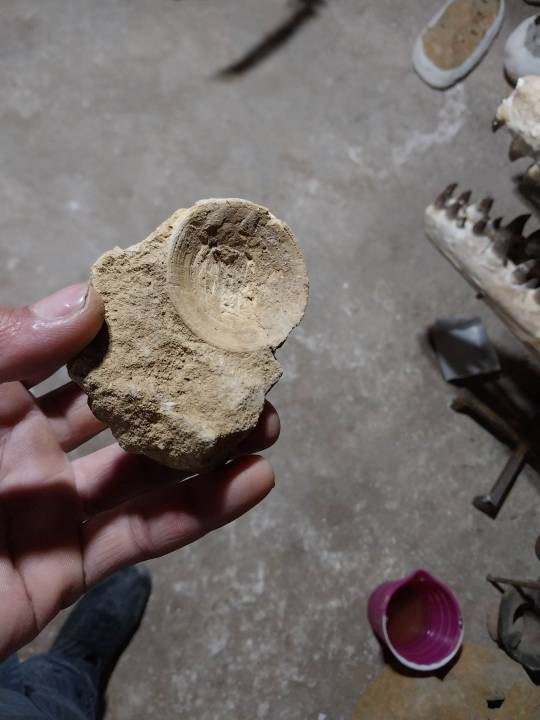
Fossil shark vertebra
25 notes
·
View notes
Text
Pachycetinae: The Thick Whales
Oh look I'm way behind not only on my work with wikipedia but also in regards to summarizing it on tumblr. Good thing, three of the pages I've worked on these past few months can just be summed up in one post because they are all one family.
So Pachycetinae, at the most basic level, are basilosaurid archaeocetes, the group that famously includes Basilosaurus and Dorudon. Reason I've picked up the articles in addition to my usual croc work, basically a friend and I noticed how lacklustre many pages are and stupidly decided to start revising all of Cetacea (pray for me).
Currently theres two genera within the group. Pachycetus aka Platyosphys aka Basilotritus, which is a whole mess I will get into at the end for those interested, and Antaecetus, which I'll just call "the good one" for now. Among those are three species. Pachycetus paulsonii (or Basilotritus uheni) from continental Europe (Germany and Ukraine mostly), Pachycetus wardii (Eastern United Staates) and Antaecetus aithai (Morocco and Egypt)
Picture: Pachycetus and Antaecetus by Connor Ashbridge


So the hallmark of Pachycetines, as the name would suggest, is the fact that their skeletons are notably denser than that of other basilosaurids. The vertebrae, the most abundant material of these whales, are described as pachyostatic and osteosclerotic. The former effecitvely means that the dense cortical bone forms thickened layers, while the latter means that the cortical bone, already forming thickened layers, is furthermore denser than in other basilosaurids with less porosities. The densitiy is increased further by how the ribs attack to the vertebrae not through sinovial articulation but through cartilage, so adding even more weight to them. Overall this is at times compared to manatees, famous for their dense skeletons.
Pictured below, the currently best preserved pachycetine fossil, an individual of the genus Antaecetus from Morocco.

Now there are some interesting anatomical features to mention that either differ between species or just can't be compared. For example the American species of Pachycetus, P. wardii, shows a well developed innominate bone, basically the fused pelvic bones. This is curious as one would think of it as a more basal feature, with derived whales gradually reducing them. The skull is best preserved in Antaecetus and has a very narrow snout. One way to differentiate the two is by the teeth. Pachycetus has larger, more robust teeth while that of Antaecetus are way more gracile and is thought to have had a proportionally smaller skull (in addition to being smaller than Pachycetus in general).
All of this has some interesting implications for their ecology. For instance, why the hell are they so dense? Well its possible that they were shallow water animals using their weight as ballast, staying close to the ocean floor. This would definitely find some support in the types of environments they show up in, which tend to be shallow coastal waters. There are some Ukrainian localities that suggest deeper waters, but that has been interpreted as being the result of migration taking them out of their prefered habitat.
Now while pachycetines were probably powerful swimmers, their dense bones mean that they were pretty slow regardless. And to add insult to injury, they were anything but maneuverable. Remember those long transverse processes? Turns out having them extend over the majority of the vertebral body means theres very little space for muscles in between, which limits sideways movements.
From this one can guess that they weren't pursuit predators and needed to ambush their prey. What exactly that was has been inferred based on tooth wear. Basically, the teeth of Pachycetus show a lot of abrasion and wear, not dissimlar to what is seen in modern orcas that feed on sharks and rays. And low and behold, sharks are really common in the same strata that Pachycetus shows up in. Now since Antaecetus had way more gracile teeth, its thought that it probably fed on less well protected animals like squids and fish.
Below: Pachycetus/Basilotritus catching a fish by @knuppitalism-with-ue
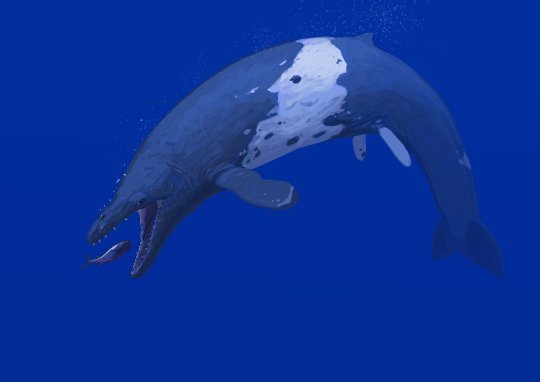
The relationship between pachycetines and other basilosaurids is wonky, again no thanks due to Pachycetus itself being very poorly known. Some studies have suggested that they were a very early branching off-shoot, in part due to their prominent hip bones, but in the most recent study to include them, the description of Tutcetus, they surprisingly came out as not just the most derived basilosaurids but as the immediate sister group to Neoceti, which includes all modern whales. Regardless, in both instances they seem to clade closely with Supayacetus, a small basilosaurid from Peru.
And now for the part that is the most tedious. Taxonomy and history.
Remains of pachycetines have been known for a while and were first described as early as 1873 by Russian scientists. To put into perspective how old that is. The material's history in science predates both World Wars, the collapse of the Russian Empire and even the reign of Tsar Nicholas II. Now initially the idea was to name the animal Zeuglodon rossicum, but the person doing the actual describing changed that to Zeuglodon paulsonii reasoning that it would eventually be found outside of Russia (something that aged beautifully given that Ukraine would eventually become independent).
And this is where the confusion starts to unfold. Because at the same time people unearthed pachycetine fossils in Germany too, which would come be given the name Pachycetus (thick whale) and be established as two species. Pachycetus robustus and Pachycetus humilis, both thought to be baleen whales.
Pictured below: Pierre-Joseph van Beneden who coined Pachycetus and Johann Friedrich Brandt who described Zeuglodon paulsonii. Beneden easily has the better beard.

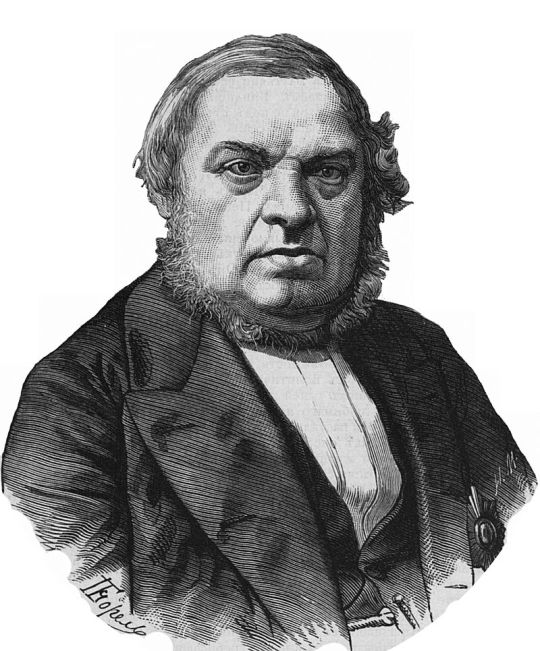
These latter two names however were later rejected in 1935 by Kuhn and lumped into other species, whereas Zeuglodon paulsonii was elevated to a full on new genus by Remington Kellogg in 1936. For those curious, Platyosphys means "broad loin", in combination with the species "Paulson's broad loin" to the amusement of some friends of mine.
And then people stopped caring and we have a nearly 70 year research gap. Eventually Mark D. Uhen found fossil material in the United States, but interpreted those fossils as being part of the genus Eocetus, naming them Eocetus wardii, a move that many following researchers disagreed with.
Then in 2001 a new species of Platyosphys, P. einori, was named. It's bad, moving on. More importantly, we got the works of Gol'din and Zvonok, who attempted to bring some clarity into the whole thing. To do so they rejected the name Platyosphys on account of the holotype having been lost sometime in WW2 and picked out much better fossil material to coin the genus Basilotritus ("the third king" in allusion to Basilosaurus "king lizard" and Basiloterus "the other king", isn't etymology fun?). They erected the type species Basilotritus uheni and then proclaimed Eocetus wardii to also belong into this genus, making it Basilotritus wardii.
This move was however not followed by other researchers. Gingerich and Zhouri maintained that regardless of being lost, Platyosphys is still valid and can be sufficiently diagnosed by the original drawings from the 19th and early 20th century. And to take a step further they added a new species, Platyosphys aithai (weird, why does that name sound familiar).
Then Van Vliet came and connected all these dots I've set up so far, noting that the fossils of Platyosphys are nearly identical to those of Pachycetus. This lead to the fun little thing were "paulsonii", applied first to Zeuglodon in the 1870s, takes priority over "robustus", coined just a few years later, BUT, the genus name Pachycetus easily predates Platyosphys by a good 60 years. Subsequently, the two were combined. Platyosphys paulsonii and Pachycetus robustus became Pachycetus paulsonii (simplified*). Van Vliet then deemed humilis to be some other whale and carried over Basilotritus uheni, Basilotritus wardii and Platyosphys aithai into the genus Pachycetus. *Technically Pachycetus robustus was tentatively kept as distinct only because of how poorly preserved it was, making comparisson not really possible.
Then finally in the most recent paper explicitly dealing with this group, Gingerich and Zhouri came back, killed off P. robustus for good, sunk Pachycetus uheni into Pachycetus paulsonii for good measure and decided to elevate Pachycetus aithai to genus status after finding a much better second skeleton, coining Antaecetus (after the giant of Greek myth).
And that's were we are right now. Three species in two genera, but only one of them is actually any good. So perhaps at some point in the future we might see some further revisions on that whole mess and who knows, perhaps Basilotritus makes a glorious comeback.
To conclude, sorry about the lack of images, despite the ample history theres just not much good material aside from that one Antaecetus fossil and I didn't want to include 5 different drawings in lateral view. Obligatory Wikipedia links: Pachycetinae - Wikipedia Antaecetus - Wikipedia Pachycetus - Wikipedia
Ideally Supayacetus will be the next whale I tackle, distractions and other projects not withstanding (who knows maybe I'll finally finish Quinkana)
#pachycetinae#pachycetus#basilotritus#platyosphys#antaecetus#archaeocete#prehistory#paleontology#palaeoblr#basilosauridae#eocene#whale
165 notes
·
View notes
Text
Fossil Friday: Archelon
Apparently, there is a sea turtle protection society in Greece by this name which is cool but I a here to talk about the ACTUAL sea turtle called Archelon ischyros. Archelon lived in the Late Cretaceous Period about 80-74 Ma. At the time, the American Midwest was overed by the Western Interior Seaway.
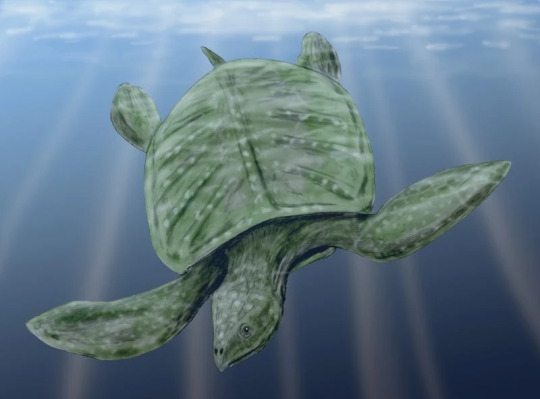
It was discovered by American paleontologist George Reber Wieland in 1895 in the Pierre Shale, a rock formation made of mostly, well, you guessed it, shale. Shales accumulate at depth in ocean basins.
Archelon lived alongside the mosasaur Platycarpus,

sharks,

(Squalus)
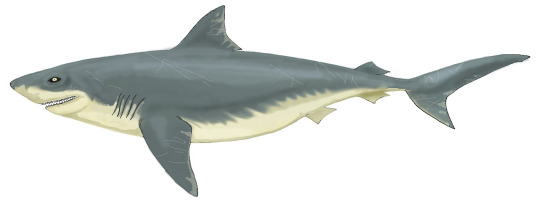
(Squalicorax)
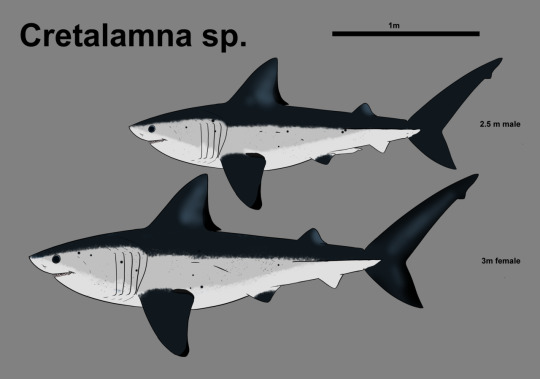
predatory ray-finned fish, Xiphactinus,
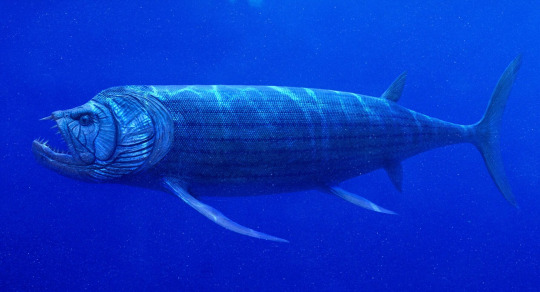
and an array of ammonites.
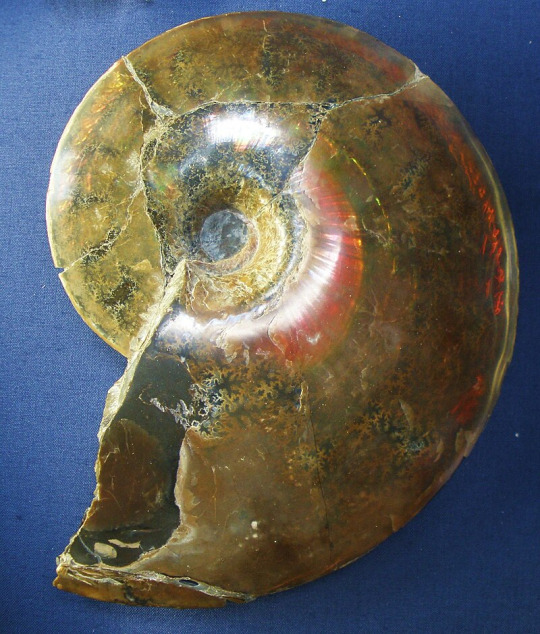
(Planticeras)

(Scaphites)
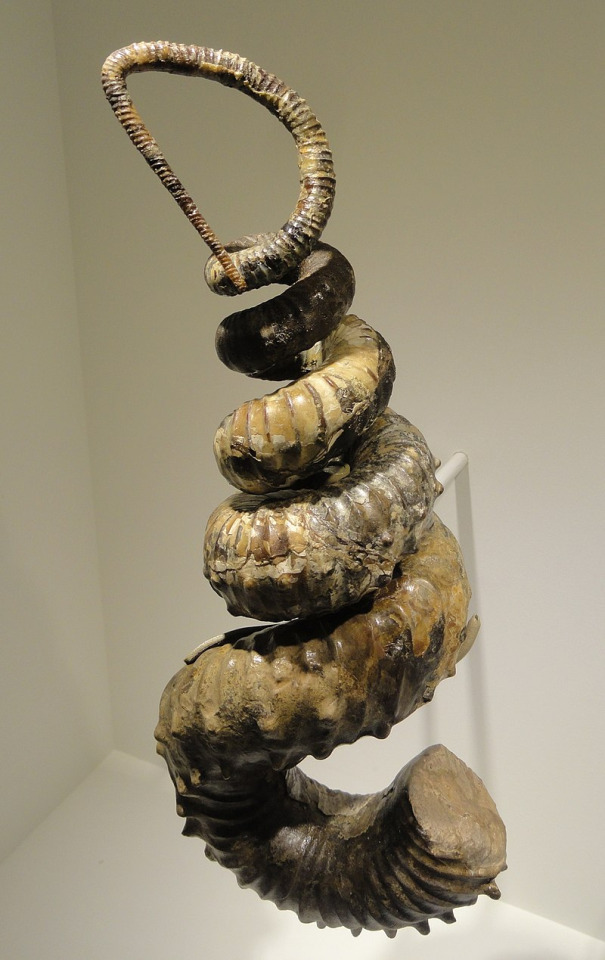
(Didymoceras)
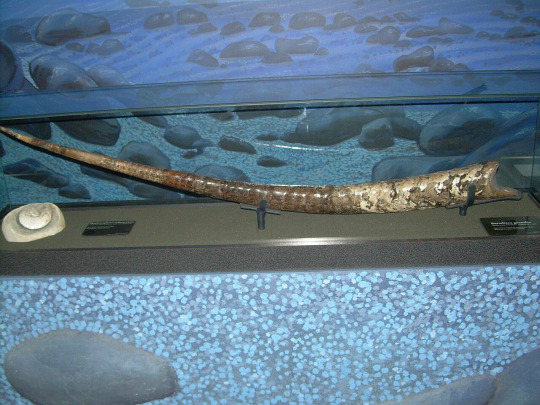
(Baculites)
Turtle phylogeny has been hotly contested for a long while thanks to their very strange morphologies (lacking extra openings in the skull, ribs and vertebrae expanding to create a shell). As of right now, most studies put them somewhere between lepidosaurs (lizards and snakes) and archosaurs (crocs and birds). It's debatable which they are closer to.
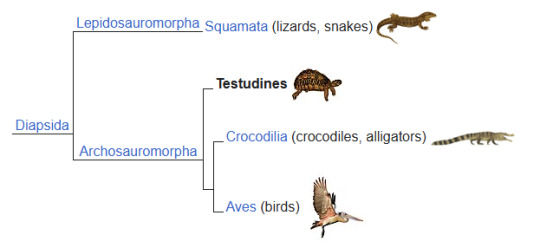
Either way, Archelon falls solidly into testudines, specifically in the clade protostegidae. This clade is completely extinct but their closest living relatives are living sea turtles.
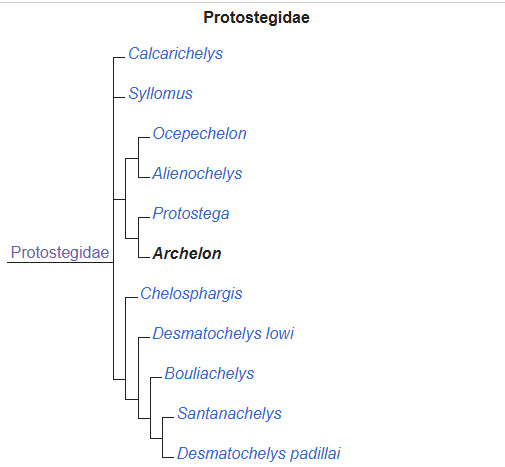
Archelon was the largest turtle to have lived at 11.5 ft long (352 cm). The largest specimen named Brigitta reached 15 ft (4.6m) in length. It had a pronounced hooked beak like a bird of prey indicating it was an obligate carnivore (must eat meat).

It's weak front flippers are similar to cheloniids (a group of living marine turtles) and indicate it probably preferred calm shallow waters to the deep sea. (Then again, it may be more like the Leatherback Sea Turtle than we realize and was a moderately good swimmer that could chase prey in the open ocean).
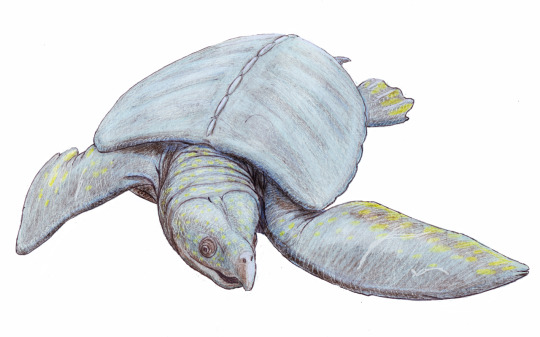
Overall, Archelon is a pretty cool animal. Have a good weekend and tune in Monday for another shiny metal. Fossilize you later!
#paleontology#fossils#fun facts#geology#science#science education#march madness#turtles#archelon#sea turtles#fossilfriday
27 notes
·
View notes
Note
I don't like appearing in one person's askbox all the time, but did you know it's WORLD DINOSAUR DAY? As such, it's DINOSAUR FACT TIME!! Not even gonna bother with rules anymore!
The dinosaur fact for today is: The Concavenator (meaning "Cuenca hunter"), is a genus of carnivorous carcharodontosaurian from the early Cretaceous, discovered in 2010 by paleontogists Fernando Escaso, José Luis Sanz, and Francisco Ortega in the Las Hoyas fossil site in Spain. With only a single species to go off of, Concavenator grew up 6 meters (20 ft) in length and 400 kg (880 lbs) in weight. The main feature that distinguished it from other carcharodontosaurians is the way its neural spines of last dorsal vertebrae created a sail. Not much is known about this genus and we haven't found many fossils, which makes gathering information on it difficult!
I hope you enjoyed dinosaur fact time today! :]
I FEEL SO BAD FOR BEING SO LATE BUT I'M HERE NOW ;__;
i wish i had a dino fact to give back,, erm,,, the t-rex had a very sensitive bundle of nerves in their noses..... which is interesting to me bc apparently shark have the same thing so i wonder why evolution just keeps bundling up the nerves in the shnozz.......
#burntasks#burntyaps#critter dino facts#GAAAH SORRY FOR BEING SO LATE#IT'S BEEN THE MOST STRESSFUL TWO WEEKS EVER
9 notes
·
View notes
Text


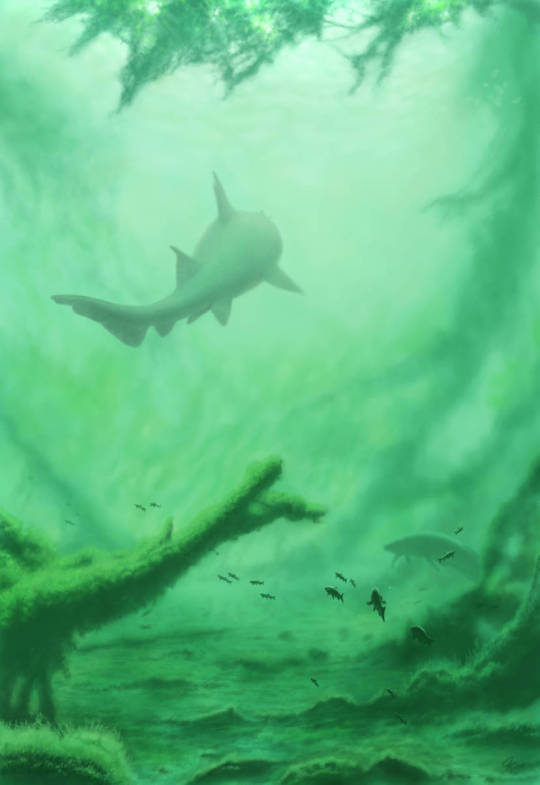
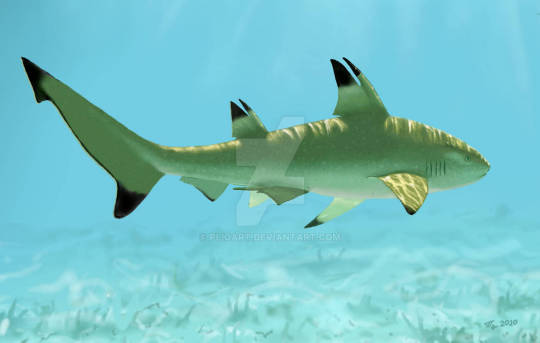

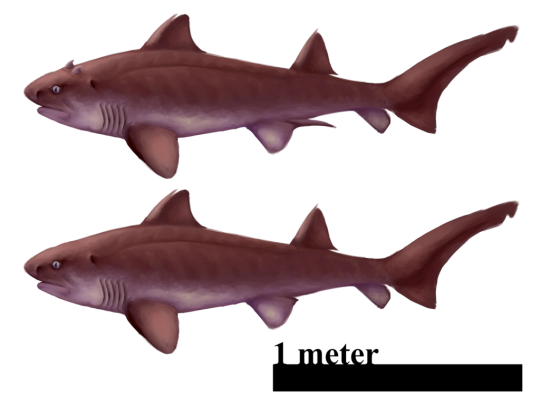

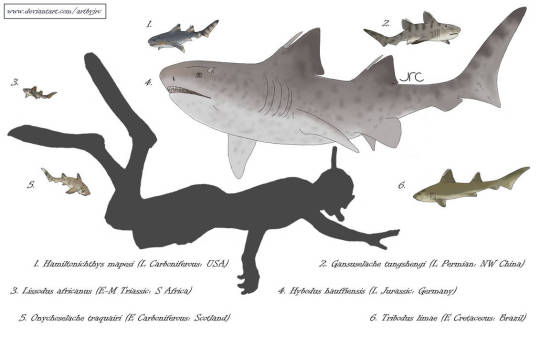
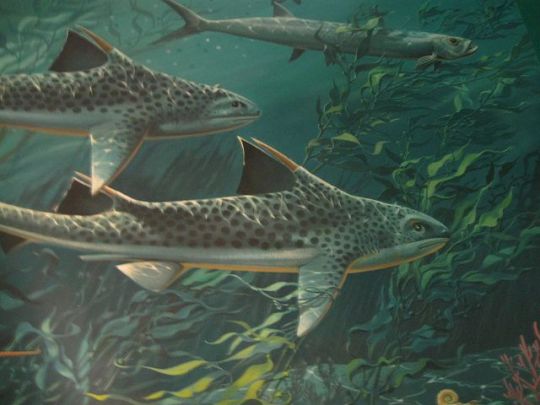
Hybodus is an extinct genus of hybodont shark-like cartilaginous fish which lived throughout much of the world’s marine, brackish, and freshwater environments from the Late Permian Period to the Late Cretaceous Period some 259 to 66 million years ago. The first known remains of hybodus consisting of various isolated teeth where collected and formally described from throughout Europe by Jean Louis Rodolphe Agassiz in 1837 whilst he worked on his five volume series: Research on Fossil Fish. He dumped the creature Hybodus meaning crooked or humped tooth in ancient greek. In the following centuries several more remains would be unearthed including spines, jaws, vertebrae, and even whole specimens. Because of this numerous species have been assigned to Hybodus with varying degrees of analysis and evidence unfortunately leading hybodus to become a bit of a wastebasket taxon which is current undergoing a broad amount of reexamination. As such the exact species count is uncertain. Although first believed to merely be an extinct example of a living shark family, in 1911 Dr. Zittel showed them to be there own distinct lineage which along with modern sharks and rays make up the the clade Euselachii. Reaching around 6.6 to 9.8ft (2 to 3m) in length, It possessed a streamlined body shape similar to modern sharks, with two similarly sized dorsal fins that would have helped it steer with precision. These fins where also lined with dentinous spines which exhibit a rib-like ornamentation located towards the tip of the spine, with rows of hooked denticles present on the posterior side. The spines may have played a role in defending the animal from predators. Hybodus is also unique in that these fish sported multiple different kinds of teeth each distinctly shaped, it is thought that Hybodus' varied dentition would have allowed it to opportunistically exploit a variety of food sources; sharper teeth would have been used to catch slippery prey, while the flatter teeth probably helped them crush shelled creatures.
Art featured can be found at the following links
7 notes
·
View notes
Text
my fossil collection is Not Big and yet it still manages to frustrate me ('it' means the piece I found at Calvert Cliffs that I don't have the expertise to ID properly but it looks???? like a piece of shark vertebra??? but I don't KNOW)
6 notes
·
View notes
Text
OOOO WE HAVE A BIG HOARDDDD
!! TW FOR ANIMAL BONES & INSECT MENTION !!

first off we hve our shrine of small plushies and dragons >:3

some of the hundreds of feathers we own, none bought, all either found ourself or given to us (THE CAMERA WOULDNT PICK IT UP RAHHHH)

or best skulls we own!! :DD from left to right: flattened snake (left of moose, got caught in hay baler and found at work), moose (cow), north american porcupine (under the moose), whitetail deer (doe), red fox (bought, bleached, badly glued teeth), coyote (male, blued together myself, named Toby), whitetail deer (buck, rodent chewed antlers away now it just has demon horn-like stubs), whitetail deer (buck, roof of mouth can separate) also some moose jaw bones behind on the right side (none of the 3 belong to the skull)

worn skull (center top, was left in the woods for 3 years before being brought in) jaw bones (upper right), deer ear (top left), unidentifiable skull (above ear), moose vertebrae (along lower shelf), nest (upper right), and a ton of rocks around! >:333 of what you cant see there is a small skull of a mouse that is less than a cm, a beaver skull, and some porcupine quills

our collection of rusty metal stuff found on the side of the road (except for the watch [found by river] and beads [found in school on floor])

our collection of old coins!! :D we even have one that goes back to the 1800s >:3 but we have a couple wheat pennies, some of those bison nickels and for some reason, we have bermuda coins, canadian coins, european coins, all that jazz

some stuff in here
in the jar? 2 cicadas, 2 bumble bees, and this STUPID FLY THAT LOOKS LIKE A BUMBLE BEE THAT GIVES US THE HEEBIE JEEBIES- >:|||
in the front you can see some discarded songbird eggshells
above those, a bit to the left, you can see some raw gypsum
in the little bowl that is barely visible (left) there are a bunch of cicada skins
to the right there are rocks and on top of the ricks you may be able to see some abandoned fishing lured that i found in another state
in the very back on the right, there is a large patterned rock, i thought it was BEAUTIFUL (i was doing nordic skiing practice so was running thru woods) couldnt leave it behind :( ran all the way back with a 5 lb rock in my arms 😭

LEFT TO RIGHT
flattened shells on the bottom
container of many small seashells
above it is some kind of cephalopod fossil
in the back in the rock is a lot of small shell fossils, very densely packed
a bit lower is some shells
between them is a green sea urchin, right under it is 2 starfish
all the way down you can see a dried up salamander
in the bottle beside it there is some shark teeth
in one of the even smaller bottles to the right (you cant see whats in it) there is a teeny tiny fully developed feather, about a half inch long
in the bag on the right there are many large bivalve shells


some pieces of the geodes I broke open (THEY LOOK WAY PRETTIER IN PERSON — THE ROOM WASNT BRIGHT ENOUGH AND WE WERE RUSHING) (AND NOOOOOOO THE BEDSHEETS GOT SO DIRTYYYY 😭)

and finally our highlighter hoard :PP (they are all nebs wives)
we just feel an instinctual urge to hoard things, mostly rocks, animal bones, and (not shown here) TONS of 4+ leaf clovers (we have over 200) we just must have it if it is of nature, we think autism takes part in it as well the bones also just interest us because of our interest in animals in general, so we just MUST keep anything we can learn about animals from >:333
i hope you enjoyed the hoardddd!! ^^
I am so curious about what fellow dragonkins hoard (for those who hoard, or have an urge to, obviously)
Like…I love to see dragonkins proud of their hoard, no matter what it is, I want to see your hoards, know about it, understand you better, see what your dragon brain and instincts decided to make you hoard
If any dragonkins (that hoard) come across this post, please tell me what you hoard I want to hear about it 😔
#therian#alterhuman#otherkin#nonhuman#alterhuman community#fictionkin#nonhuman community#furry#copinglink#otherhearted#dragonkin#dragon kin#dragon therian#dragon fictionkin#draconic#draconic community#feathered dragon#httyd dragon#asian dragon#vulture culture#animal bones#bone collecting
234 notes
·
View notes
Photo

Fossil Shark Vertebra - Eocene, Ouled Abdoun, Morocco - Genuine Prehistoric Fossil
This is a genuine fossil specimen of a Shark Vertebra, discovered in the Eocene-aged phosphate deposits of Ouled Abdoun, Morocco. This vertebra belonged to an ancient shark that swam the prehistoric seas approximately 56-34 million years ago. The fossilized vertebra has been naturally preserved, displaying remarkable detail of its structure and growth rings.
Key Features:
Fossil Type: Shark Vertebra
Age: Eocene (~56-34 million years old)
Formation: Ouled Abdoun Phosphate Deposits
Location: Ouled Abdoun Basin, Morocco
Condition: Well-preserved, showing detailed growth rings and structure
Authenticity: 100% genuine fossil, supplied with a Certificate of Authenticity
Photo: The item in the listing is the exact specimen you will receive
Fossil shark vertebrae like this are highly sought after due to their rarity and scientific value. Unlike bony fish, sharks have cartilaginous skeletons, making their fossilized remains less common. However, phosphate deposits such as those in Morocco provide excellent conditions for preservation, allowing us to study these ancient marine predators in detail.
This shark vertebra is a fascinating piece of natural history and an excellent addition to any fossil collection, educational display, or scientific study. It also makes a fantastic gift for fossil enthusiasts, marine biology lovers, and collectors of prehistoric remains.
Additional Information:
Scale cube = 1cm for size reference. Please see listing photos for full dimensions.
This is a carefully selected, high-quality specimen.
Ships securely packaged to ensure safe arrival.
All of our Fossils are 100% Genuine Specimens & come with a Certificate of Authenticity
Fast & Secure Shipping – We take great care in packaging each fossil to ensure it arrives in perfect condition!
Own a unique piece of prehistoric history – add this Eocene Fossil Shark Vertebra to your collection today!
#Fossil Shark Vertebra#Shark Fossil#Eocene Fossil#Ouled Abdoun Fossil#Morocco Fossils#Marine Fossil#Vertebra Fossil#Prehistoric Shark#Paleontology#Fossil Collecting#Authentic Fossil#Natural History#Fossil Specimen#Geological Collectible#Fossil Gift#Science Gift#Fossilized Bone#Fossilized Cartilage#Fossil Shark Spine
0 notes
Text


i grew up (relative, navy brat) on the shores of the Chesapeake Bay where the eroding cliffs were filled with miocene era fossils (23–5 million years ago). Most exciting was, of course, the shark teeth. Collecting them was an everyday activity and we’ve had this giant vase of them for decades now. I used a fossil guide to categorize them today.
#*#just missing hammerhead#the waters then were tropical so lots of cool sharks and shit#also camel fossils and random shit like that can be found#there’s a couple vertebrae in this jar but fuck if i know who they belong to#not shark that’s all i know lol
11 notes
·
View notes
Text
How would you like the chance to get this fossil starter set for just £1 including free UK 2nd class postage? 👀 The set contains a number of fossils: 1 mosasaur tooth 1 crow shark (Squalicorax pristodontus) tooth 1 Eocene Fish vertebrae 1 heliophora sand dollar 1 toxaster Echinoid (sea urchin) 3 sand shark teeth The winner will be drawn at random once all 30 tickets have been sold, and will receive the fossils pictured. The set can be posted first class for an extra £1. The set can be posted internationally for the difference in cost between domestic and international postage. Payment is safe and secure by PayPal, just send me a message here, on Facebook or via email ([email protected]) to buy your ticket(s).
I also have a number of ethical sourced items available at www.cambriancuriosities.co.uk







#Fossil#Fossils#Sea urchin#Urchin#Echinoid#Sand dollar#Fish#Vertebra#Vertebrae#Bone#Rock#Geology#Dinosaur#Dinosaurs#Collection#goblincore#Mosasaur#Tooth#Shark#Sand shark#Crow shark#Squalicorax#Pristodontus#Squalicorax pristodontus#Reptile#Cretaceous#Eocene#History#Museum#Natural history
0 notes
Text
Cretaceous Relics from a Dusty Shelf
Shark teeth that I found back when I was in college. Common enough but these are from the Cretaceous period. Where I live in United States was underwater during the Cretaceous:

This is not a shark’s tooth. It is conical which means reptilian. It is a mosasaur tooth:

The ammonite and the fish fossil were gifts from my sister and the shells are from various trips to Florida but those vertebrae are from a mosasaur that I found:

#fossils#shark teeth#mosasaur tooth#mosasaur vertebrae#cretaceous#cretaceous mid-south#life in memphis
3 notes
·
View notes
Text
Fossil Friday: Lisowicia bojani
I am still geeking out over how far this animal made it during March Madness. Lisowicia bojani lived in Poland during the Late Triassic Period about 210-205 Ma. It was discovered in 2006 by Polish paleontologists Jerzy Dzik, Tomasz Sulej and Grzegorz Niedźwiedzki, who initially thought it was a sauropodomorph. I mean, can you blame them? This thing is HUGE. it wasn't officially named until 2019 though.
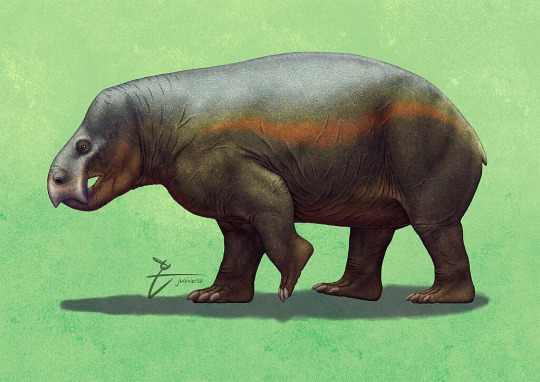
It was found in the Lipie Śląskie clay pit which consists mostly of green mudstones. It's home would have been wet and swampy, akin to the modern day Everglades with large meandering rivers, oxbow lakes and surrounded by abundant vegetation, mostly conifers, ferns, and cycads.
It lived alongside animals such as the archosaurs Smok (who was probably the apex predator),

a silesaurid, a small theropod dinosaur, pterosaurs, a small crocodylomorph, a sphenodont, primitive amphibians, lungfish, coelacanths, hybodontid sharks and a smaller synapsid called Hallautherium.
it belongs in the phylum Chordata (vertebrates) in the clade Amniota in the smaller Synapsida clade (animals with one pair of temporal fenestrae in their skull), continuing into the even smaller Therapsida clade (mammals and their closest relatives).

Within Therapsida, they belong to the suborder anomodontia in the clade dicynodontia.
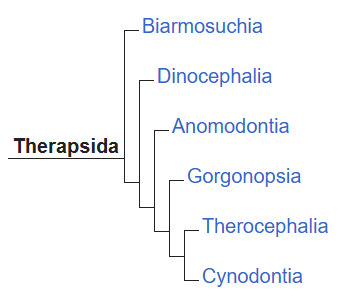

Dicynodonts are a group of tusked, beaked herbivorous synapsids that ranged from the mid-Permian to the Late Triassic. Lisowicia was the largest of this highly successful group.

It had very large temporal fenestrae which allowed for large jaw muscles to attach at the back of the skull. It was a stocky animal like its closest relatives. It was completely toothless and lacked the tusks of other dicynodonts
It's cervical vertebrae have hollows excavated along the lateral sides but lack pleurocoels so their function is currently unknown.
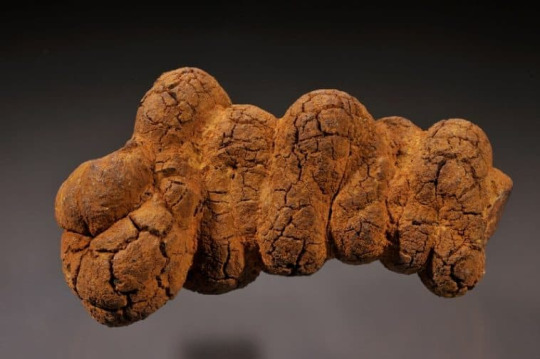
Coprolites attributed to Lisowicia have been found in abundant accumulations that have been interpreted as a sort of communal bathroom. It seems these animals could have been litter box trained! Within these coprolites have been found evidence of soft vegetation and conifers and occasionally woody material.

The bones of Lisowicia lack clear lines of arrested growth (LAGs) which might suggest that they grew very rapidly without interruptions until they reached adult size. LAGs may have either been absent or erased due to extensive remodeling of bone into adulthood which is similar to mammals and some dinosaurs. This would support permanently rapid growth.
Hope you enjoyed this week's lessons and I hope you tune in Monday to learn about another popular metal. Fossilize you later!
#paleontology#fossils#fun facts#science education#science#science side of tumblr#synapsid#dicynodont#march madness
17 notes
·
View notes
Text
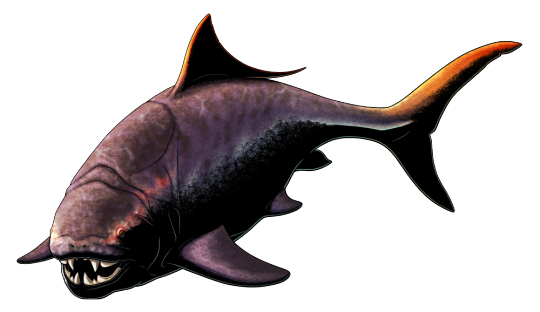
With its armored head and blade-like jaws, the placoderm fish Dunkleosteus terrelli is an iconic Paleozoic animal.
Living during the Late Devonian, about 375-359 million years ago, in subtropical waters covering parts of what are now North America and Europe, this species is known mostly just from the bony plates that covered its head and thorax. The rest of its skeleton was cartilaginous and rarely ever fossilized (only a few vertebrae and the pectoral fin are currently known), so its full body shape and size is poorly understood, and previous length estimates have ranged all the way up to 10m (33').
…Except it turns out it wasn't nearly that big.
Based on its head proportions, along with comparisons to more complete remains of other arthrodire placoderms, recent studies instead come up with a maximum length of about 4m (~13ft) – giving Dunkleosteus a much shorter-but-heavier chunky body shape, more like a tuna than a shark.
But even after this size revision Dunkleosteus would have still been one of the largest animals around at the time, with the ability to snap its jaws open at high speed and an incredibly strong bite force. It was probably specialized to mainly prey on other heavily-armored animals such as other placoderms and shelled cephalopods, and was likely a strong swimmer with a shark-like tail fin.
Preserved stomach contents in one fossil show remains of the fast-swimming cartilaginous fish Orodus – suggesting that much like the modern tuna it resembled, Dunkleosteus was also capable of bursts of high speed.
———
NixIllustration.com | Tumblr | Twitter | Patreon
#science illustration#paleontology#paleoart#palaeoblr#dunkleosteus#dunkleosteidae#arthrodire#placoderm#fish#art#chunkleosteus#big chonk#a very shaped animal#gotta go fast
898 notes
·
View notes
Text
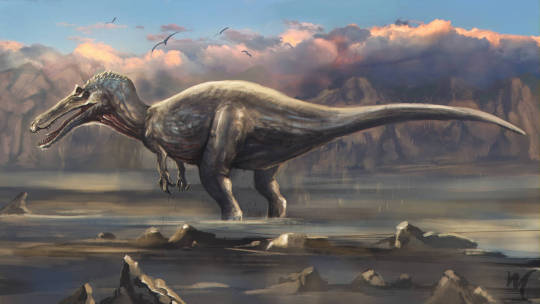
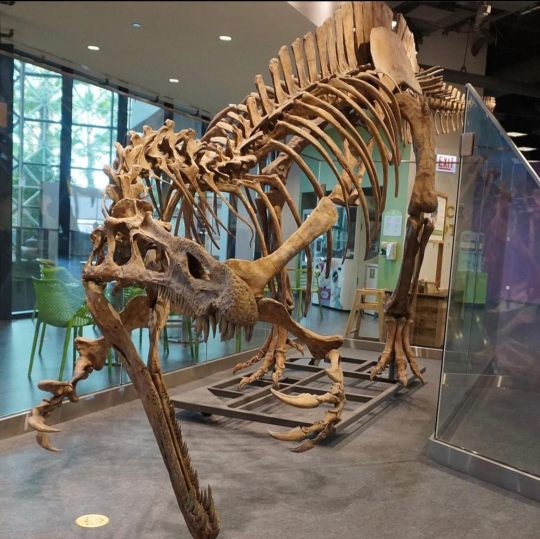
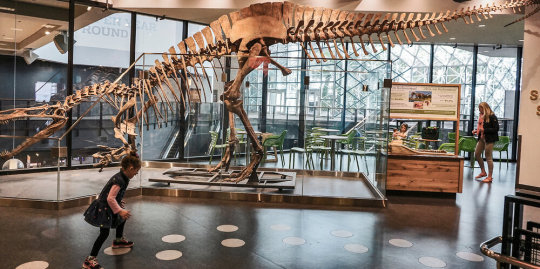
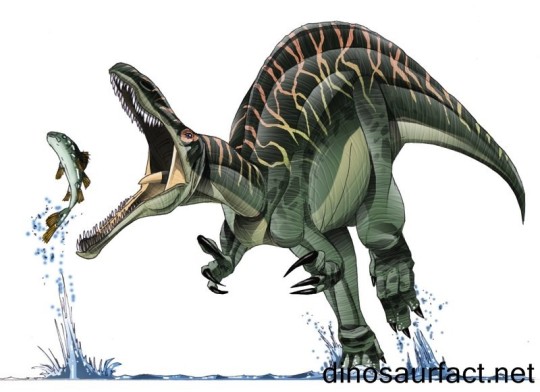
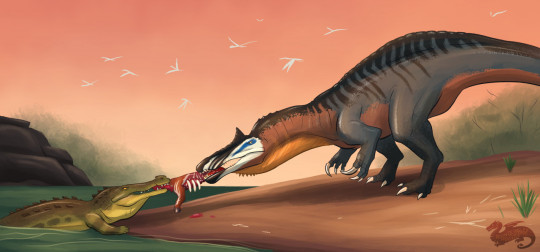
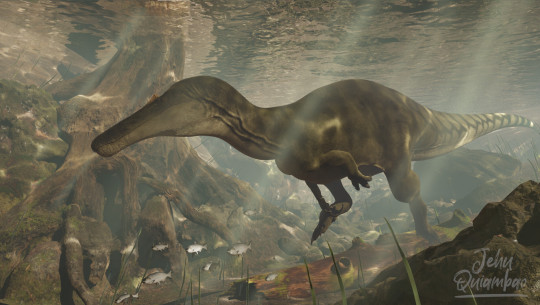
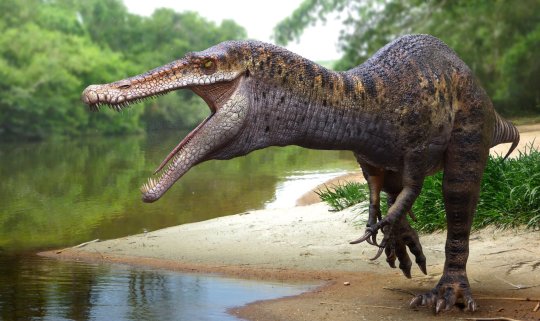
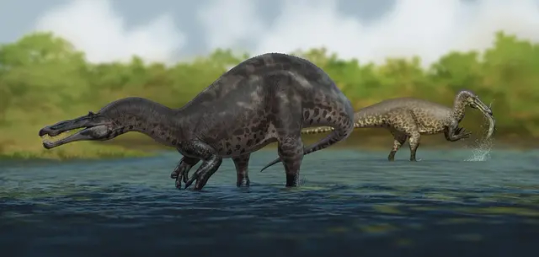
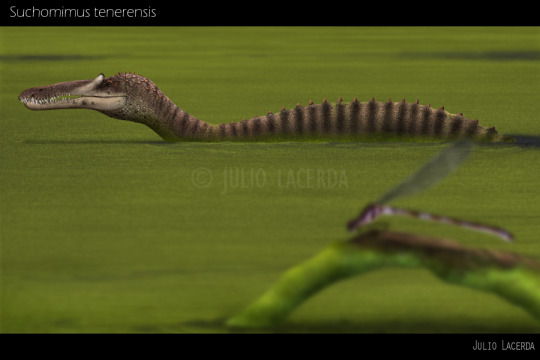
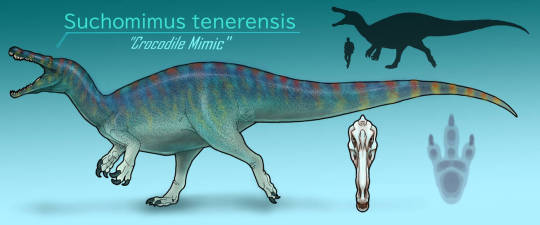
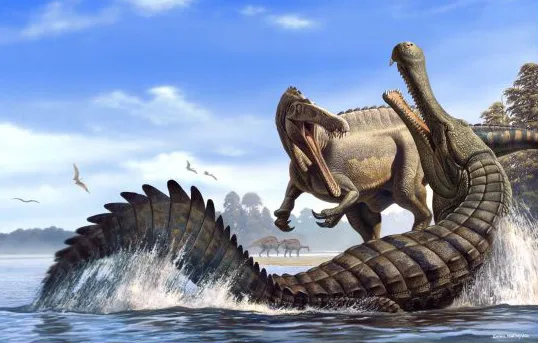
Happy Dinosaur Day: Suchomimus is a genus of spinosaur theropod dinosaur that lived throughout what is now North Africa during the Aptian and early Albian stages of the Early Cretaceous period some 125 to 112 mya. The first remains of suchomimus consisting of a giant thumb claw was discovered by David Varricchio in December of 1997 in Niger while he was working for a paleontological dig lead by Paul Sereno. Throughout 1997 and 1998 the dig team would unearth a 2/3rds complete giant theropod skeleton. In 1998 Paul Sereno, Allison Beck, Didier Dutheil, Boubacar Gado, Hans Larsson, Gabrielle Lyon, Jonathan Marcot, Oliver Rauhut, Rudyard Sadleir, Christian Sidor, David Varricchio, Gregory Wilson and Jeffrey Wilson would name and describe the animal as Suchomimus tenerensis. The generic name Suchomimus meaning "crocodile mimic” in Ancient Greek, and the specific name tenerensis is after the Ténéré Desert where the animal was found. Since then several more specimens have been recovered. Reaching around 31 to 36ft (9.5 to 11m) in length and 5,500 to 11,700lbs (2,500 to 5,300kgs) in weight, suchomimus was a massive animal which had a long & low crocodile like skull supported by a thick but short neck. It had sturdy hind legs and powerfully built forelimbs which bore a giant claw on each thumb. Along the midline of the animal's back ran a low dorsal sail, built from the long neural spines of its vertebrae. Like other spinosaurids suchomimus would have lived near bodies of water. The bulk of its diet of was likely comprised of boney fish, eels, sharks, rays, and amphibians, occasionally being supplemented with pterosaurs, crocodilians, and other dinosaurs.
Art used can be found at the following links
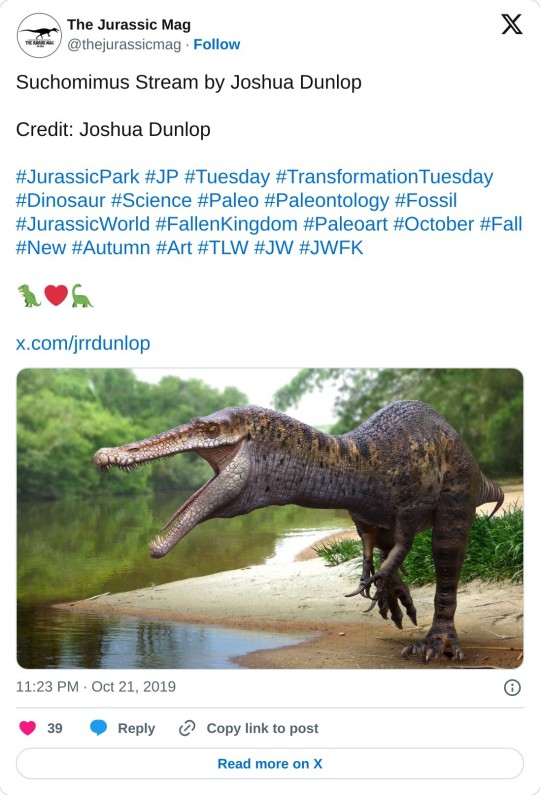
#pleistocene pride#pliestocene pride#mesozoic#suchomimus#spinosaur#elrhaz#africa#cretaceous#dinosaur#dinosaur day
5 notes
·
View notes
